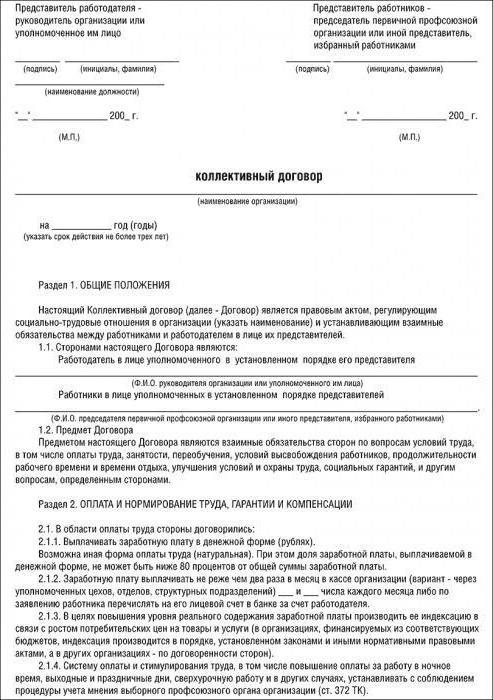It is possible to regulate labor relations by concluding a collective agreement. In some cases, this type of agreement allows the parties to include in the collective agreement some clauses that are not included in ordinary agreements. Let us consider in more detail what the collective agreement includes and what are the nuances of the conclusion.
The concept
Given the provisions of the Labor Code of the Russian Federation, a collective agreement means a legal document that regulates the social and labor relations of workers and the employer represented by their representatives.

Legislatively established the legal basis for the development of a draft agreement, its conclusion and implementation of requirements, as well as developed regulation of relations in the interests of two parties to the document.
All tasks are feasible, and the goals that the contract sets are achievable if there is a social partnership. According to the Federal Law, the relations of trade unions and the employer (or associations of employers) should be built on the basis of social partnership and interaction between the parties. A collective bargaining agreement is a form of such partnership at the organization level. The content of collective agreements and agreements should express the interests of both parties (social groups).
Parties
A collective agreement is concluded between the employees of the enterprise and directly its head or his authorized person. In the role of a representative on behalf of the head may be his deputy, the head of a department, a lawyer of the enterprise, as well as any third-party person authorized by the representative. Any elected body may speak on behalf of employees. In special cases, it is a trade union organization.
These parties determine the content and structure of the collective agreement, as well as the timing of its conclusion. Why do organizations resort to this type of agreement? Because it carries more expanded obligations than a regular labor contract.
Main goals
The content and structure of the collective agreement are determined by its main objectives. These include:
- Regulation of relations between employees and a manager.
- Motivation of employees to solve production problems.
- Material interest of employees in applying non-standard approaches during the execution of production tasks.
- Establishment of a unified system of remuneration.
- Optimization of management of salary costs for employees.
- Establishment of optimal conditions for social protection of workers.
These goals can be settled by the team and expanded at its discretion.
Structure
As mentioned earlier, the content, structure of the collective agreement is determined by employees. The structure of the terms of the agreement has three types:
- Normative. This includes local rules that are established by the parties to the agreement and apply to them. Legislatively established clear relationships between regulations. This type assumes preferential and social conditions relative to those established by law (additional leave, allowances, early retirement, etc.). The norms established in the collective agreement are the mutual will of both parties.
- Required. These include those conditions that are binding. Specific dates and responsible persons are indicated here. This type of agreement structure is valid until the fulfillment of obligations and ends when the obligations are fulfilled.
- Informational.This includes selective provisions from legislative acts, documents on social partnership (those parts where labor, economic and professional relations are regulated). The inclusion in the structure of the agreement of this type of conditions should not overload the main content of the document.
Content
The content of the collective agreement is determined by its structure. It includes:
- the form of payment for labor activity, its size and systematic nature of payments, various kinds of remuneration, compensation, supplements, social benefits;
- the basis for regulating payments based on rising prices, inflation, and labor indicators; coordination of retraining, advanced training and employment of workers;
- a system of schedules for working hours and rest of employees, as well as holidays; labor protection conditions, in particular for women and children;
- provisions on medical and social insurance;
- conditions for observing the interests of the collective in case of its possible transfer to another owner;
- provisions on the protection of the health of employees, environmental safety in the organization;
- indication of the duration of the agreement;
- provisions on benefits for workers who combine study and work;
- control over the implementation of the provisions of the contract, the responsibility of the parties, ensuring normal conditions for the work of elected and other authorized bodies;
- non-strike clause.

Any other conditions: economic, preferential, social - may also be included in the content of the collective agreement. The effect of the collective agreement, its conclusion and terms are determined by mutual agreement of its parties, which should be supported by an order for the enterprise.
Conclusion procedure
The collective agreement (concept, order, content we consider in this material) is determined at the negotiations of the parties. They can be initiated both by employees and by the employer.
The start of negotiations is the sending by one side of a letter about the beginning of the dialogue. The other party, within one week from the moment of receipt of the letter, must send a response, which will indicate the persons who are members of the collective bargaining commission, as well as their powers.
The day that follows the day the response is received can be considered the beginning of a dialogue between the parties that will conduct the conclusion of the collective agreement. The content of the collective agreement, its terms, procedure, and also the place of negotiations will have to be determined by authorized parties.
If the initiator of the dialogue is the primary trade union organization, a single representative body or other authorized person who represents the workers, then together with a letter about the start of negotiations, you should send a message about this fact to all trade union organizations that unite employees of one enterprise.

Within 5 days, a representative body is elected by the staff. If the response to the notice of the start of negotiations is not received or it is negative, the dialogue may begin without representatives.
But the primary trade union organization that does not participate in the negotiations has the right to send its person to the representative body within 30 days.
If a collective agreement, the content and procedure of conclusion of which is determined by authorized parties, is concluded in a separate division of the organization, then the head of this division must be endowed with the necessary powers in accordance with legislative acts. Their representative receives the right to represent the employees of the unit, subject to the provisions of Art. 37 of the Labor Code of the Russian Federation.
A special moment is the fact that the parties must present to each other no later than 14 days from the time of the request the necessary information that is needed for negotiations.If during the dialogue controversial situations arose and no compromise was reached on them, then within 90 days from the start of the whole process, the content of the collective agreement is determined by those positions that have been approved. At the same time, a protocol of disagreement should be drawn up. Later, these provisions can be brought up for collective discussion.
Within one week from the moment the agreement was signed, it must be sent by the employer or his representative for registration to the appropriate authority. This body identifies all conditions that worsen the situation of workers in the enterprise. This fact is based on the provisions of labor law and other regulatory acts.
Further, the results of the inspection are reported to the state inspectorate and representatives of the parties that have concluded the collective agreement. The content of the collective agreement should be amended as amended, and those conditions that worsen the situation of employees should be excluded. But this does not affect the entry into force of the agreement itself, and all additions and changes can be made in accordance with the procedure established by the document. The implementation of all clauses of the agreement must be monitored by the parties to the social partners or their representatives.
The timing
The beginning of the collective agreement is considered the day when both parties put their signatures. Collective agreements (the concept, content, conclusion of such documents we have described in detail in this article) are signed for a period of one to three years.

For a longer period of time, contracts of this type are not concluded. Moreover, the decision of the collective bargaining commission is considered valid if more than 50% of its participants voted for the signing of the document.
Renewal
The concept and content of the collective agreement we have considered above. Such documents should take into account the provisions of the Labor Code. In accordance with this, the parties to the agreement may extend the validity of the document when the previous period has expired. This fact may be included in the condition for automatic renewal. But the conclusion of the agreement, as well as its extension, cannot exceed three years.
Automatically a collective agreement can only be renewed if neither side opposes this action.
But by law, both the employer and employees may be willing to draw up a new agreement. In this case, the previous content of the collective agreement will be canceled, together with the terms and conditions.
The parties must remember that the contract should contain a clause on the terms of its validity. Otherwise, the automatic extension of the contract will be considered illegal and contrary to the Labor Code of the Russian Federation.
Employee Benefit
Depending on the financial and economic situation of the organization, the employer may establish certain guarantees and benefits for employees. For example, it can create more favorable conditions for the fulfillment of labor obligations than the law provides.
The Labor Code of the Russian Federation is prohibited from including in the content of the agreement those provisions that infringe on the rights of employees. This fact may be lawful only when the employer undertakes to compensate for the restrictions by providing any benefits. At the same time, each employee can choose how the reimbursement will take place. The concept, parties and contents of the collective agreement are presented in this material, such a document implies the regulation of social and labor relations between the parties.
A responsibility
The legislation provides for employers and their authorized persons various types of responsibility, and especially administrative.As for trade union organizations and other representatives of employees, administrative responsibility does not apply to them. An exception may be the fact of an illegal strike (if it is proved).

According to the Labor Code of the Russian Federation, the concept and content of a collective agreement implies several types of offenses that entail liability:
- The moment of deviation from participation in negotiations or violation of the relevant deadlines.
- Failure or violation of the terms of the contract.
- Failure to provide information necessary for negotiating and exercising control.
The collective agreement (the parties, the content of which is agreed upon at the time of negotiations) should provide for moments of responsibility of both parties, and the imposition of penalties for failure to comply with the conditions should be regulated by the RF Code of Administrative Offenses.
Regulatory nature
The content of the collective agreement should apply to an unlimited number of employees.

For example, if the employer wants to increase the salary level in the organization, then this fact will also apply to newly arrived employees.
Guarantees
Consider the guarantees that are provided to those persons who participated in the negotiations:
- a person is exempted from work with the preservation of his salary and workplace (no more than three months);
- the costs associated with negotiating should be compensated in accordance with the law (the content of the collective agreement should take this into account);
- Third-party specialists are paid by the party that invited them.

Termination
The Labor Code of the Russian Federation regulates the reasons why a collective agreement can be terminated:
- Expiration date.
- Liquidation of the enterprise.
- Change of ownership.